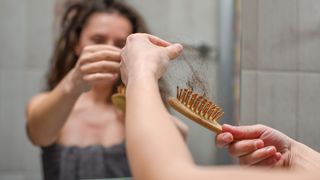Alopecia: Causes, symptoms & treatments for hair loss and balding
Hair loss, or alopecia, has many causes and can affect virtually anyone.

Hair loss, or alopecia, has many causes and can affect virtually anyone.
Alopecia may affect just the scalp — commonly referred to as balding — or it may result in hair loss across the entire body, according to the Cleveland Clinic.
Everyone sheds about 100 hairs each day as part of the normal hair growth cycle, but this loss usually is not noticeable because we have new hairs growing to replace the old ones. True hair loss happens when new hair doesn't grow to replace the hair that's fallen out, according to the Mayo Clinic. Americans spend more than $3.5 billion each year trying to treat it, according to the American Hair Loss Association.
Symptoms & causes

Most people's hair grows about a half-inch per month, and about 90% of your hair is actively growing at any given time, with the other 10% in a dormant phase. After two or three months, this dormant hair falls out and its follicles begin growing new hair as other follicles begin a dormant phase.
Shedding hair is different from hair loss. The former occurs when you shed more hair than normal, but new hair is still growing in; the latter occurs when a hair falls out and doesn't grow back. People may temporarily shed hair during stressful events, such as a breakup or divorce or during times of grief, according to the American Academy of Dermatology (AAD) .
Hair shedding "still doesn't feel good, and it takes the hair [awhile] to reach a certain length where you perceive its presence," said Doris Day, a board-certified dermatologist New York City and an attending physician at Lenox Hill Hospital, also in New York. "So it feels like a hair loss, but it's not a hair loss."
Noticeable hair loss can be caused by wide variety of factors, including:
Hereditary hair loss: This is the most common cause of hair loss, and affects both men and women. It's known medically as androgenic alopecia, and also referred to as male-pattern baldness or female-pattern baldness. This type of hair loss often follows an expected pattern, including a receding hair line in men, and a thinning along the crown of the scalp in women, according to the Mayo Clinic. The exact cause is not known, but it's thought that certain genes cause the hair follicles to shrink and gradually stop growing hair, according to AAD.
Immune system disorders: An autoimmune condition called alopecia areata, which has no cure, occurs when the immune system attacks hair follicles, according to the National Institute of Arthritis and Musculoskeletal and Skin Diseases (NIAMS). It typically results in hair loss in small, round patches on the scalp. Most people with alopecia areata develop the condition relatively early in life, in the teen or young adult years, according to NIAMS. In rare cases, alopecia areata can result in nearly completely loss over the entire body.
Harsh hairstyles or treatments: Hairstyles that consistently use rubber bands, rollers or barrettes, or pull hair into tight styles such as cornrows, can inflame and scar hair follicles. So can incorrectly used chemical products such as dyes, bleaches, straighteners or permanent wave solutions. Depending on the degree of damage, the resulting hair loss can be permanent.
Hormone imbalances: In women, hormonal shifts from birth control pills, pregnancy, childbirth, menopause or hysterectomy can induce more hair follicles than normal to enter the dormant phase.
Illness or surgery: The stress from sickness or surgery may prompt the body to temporarily cease nonessential tasks such as hair production. Specific conditions can also trigger it, including thyroid disorders, syphilis, iron deficiency, lupus or severe infection.
Medications and vitamins: Cancer chemotherapy, which attacks hair follicles in its attempt to kill all fast-growing cells around the body, is a well-known reason for hair loss. Other medications' side effects include hair shedding as well, such as some that treat high blood pressure and gout (a painful joint condition caused by a buildup of uric acid). Excessive levels of vitamin A also contribute.
Nutritional deficits: Heavy dieting or eating disorders such as bulimia and anorexia can temporarily stun hair follicles to cease growth. This can also occur from insufficient protein, vitamin or mineral intake.
Aging: A natural effect of growing older is slowed hair growth.
Women usually don't go completely bald with age, but instead lose hair on the top of the head or the temples. Men tend to lose hair on their temples, and are more likely than women to go completely bald, Day said.
Infections: Certain infections can cause hair loss, including a fungal infection known as tinea capitis, which causes a form of patch hair loss, according to Harvard Medical School.
Diagnosis

Dermatologists will examine the person's scalp and take a history of medical or stressful events "to see what's been going on in their life and their world," Day said.
The dermatologist may take a biopsy — a small patch of skin that includes the hair follicle — and send it to a pathologist to determine if an autoimmune disease, such as lupus, is the cause of the hair loss.
Examining the hair and follicle can also determine whether someone has a bacterial or fungal infection, Day said.
Treatment & medication

Hair loss remedies range from the mild to the extreme and the inexpensive to the costly. Much depends on how much hair is gone and how high a priority it is to mask its absence or replace it.
According to the Cleveland Clinic, treatments include:
Hair weaves or wigs: Typically expensive, wigs and hair weaves either completely cover the head or add to existing hair, restoring the appearance of a full head of hair. They are especially practical for cancer patients and those whose hair loss is temporary.
Topical creams and lotions: Over-the-counter minoxidil (also known by the brand name Rogaine) can restore some hair growth, especially in those with hereditary hair loss. It is applied directly to the scalp. Prescription-strength finasteride (Propecia) comes in pill form and is only for men. According to the American Academy of Family Physicians (AFP), it may take up to six months to tell if these medications are working.
Anti-inflammatory medications: Prescription steroid-based creams or injections can calm follicles damaged or inflamed by harsh chemicals or excessive pulling.
Surgery: Men tend to be better candidates for surgical hair-replacement techniques because their hair loss is often limited to one or two areas of the scalp. Procedures include grafting, which transplants from one to 15 hairs per disc-shaped graft to other locations. Scalp reduction removes bald skin from the scalp so hair-covered scalp can be stretched to fill in the bald areas. Side effects include swelling, bruising and headaches.
Hair-growth laser treatment can also help stimulate hair follicles and improve growth, Day said. People often see results when they combine laser treatment with another intervention, she said. Treatments range in price from $30 and up for Rogaine to about $3,000 for laser treatment, she added.
Natural and alternative therapies
According to NIAMSD, alternative therapies may not help hair regrow and many are not supported by medical research.
However, if blood tests show that you aren't getting enough of certain vitamins and minerals, such as biotin, iron or zinc, a dermatologist may recommend that you take a supplement to treat this deficiency, according to the AAD. But you shouldn't take biotin, iron or zinc supplements if you have normal levels of these vitamins and minerals in your blood, because getting too much biotin, iron or zinc can be harmful, according to the AAD.
The NIAMSD recommends discussing any alternative treatments with physicians before use.
Latest treatment developments
The drug Tofacitinib is approved to treat adults with arthritis, but a growing number of cases suggest that it can also treat alopecia universalis, a condition in which people lose all of the hair on their body because their immune system attacks hair follicles, Live Science previously reported.
The finding occurred after doctors prescribed a 25-year-old man with alopecia universalis the drug because they had heard it had treated a similar condition in mice, according to a statement from Yale University. After three months of treatment, the man had completely regrown the hair on his scalp, and he had visible eyebrows, eyelashes and facial hair, as well as hair elsewhere on his body.
"It's exciting," said Day, who did not treat this particular patient. "There seems to be a real effect here."
It's unclear how Tofacitinib (brand name Xeljanz) works, but researchers hope to determine its mechanism soon. This data may help them learn which biological pathways lead to hair loss.
There are now clinical trials taking place around the country to test the safety and efficacy of the drug for hair loss conditions. One such study lasting 3 months gave Tofacitinib to 66 people with alopecia areata. Half of the people regrew some hair, and one-third had more than 50% of the hair on their scalp grow back, according to the 2016 study, published in the journal JCI Insight.
However, researchers are still working to determine the best dose needed, whether the results are lasting, and whether they can develop a topical form of the drug, Day said. She added that patients should be aware that Tofacitinib has side effects. It's already associated with an increased risk of serious infections, as well as stomach and intestinal tears, according to Pfizer, the manufacturer.
Besides investigating Tofacitinib, researchers are also looking at ways to clone hair or use stem cell therapy to treat alopecia, Day said.
Additional resources
The National Institute of Health offers ways to cope with alopecia areata. You can also read stories written by people with alopecia areata at the National Alopecia Areata Foundation. And you can learn more about different types of hair loss and the diagnostic process for each at the American Academy of Family Physicians.
Bibliography
Crispin, M.K. et al. (2016, Sept. 22). Safety and efficacy of the JAK inhibitor tofacitinib citrate in patients with alopecia areata. JCI Insight. doi: 10.1172/jci.insight.89776.
Gershon, Eric. (2014, June 19). In hairless man, arthritis drug spurs hair growth — lots of it. Yale News. https://news.yale.edu/2014/06/19/hairless-man-arthritis-drug-spurs-hair-growth-lots-it
American Academy of Dermatology Association. (n.d.). Do You Have Hair Loss or Hair Shedding? https://www.aad.org/public/diseases/hair-loss/insider/shedding
American Academy of Dermatology Association. (n.d.). Hair Loss: Who Gets and Causes https://www.aad.org/public/diseases/hair-loss/causes/18-causes
American Academy of Dermatology Association. (n.d.). Hair Loss: Diagnosis and Treatment. https://www.aad.org/public/diseases/hair-loss/treatment/diagnosis-treat
American Hair Loss Association. (n.d.). Hair Loss Treatment. https://www.americanhairloss.org/hair_loss_treatment/default.html
Cleveland Clinic. (2018, April 3). Alopecia Areata. https://my.clevelandclinic.org/health/diseases/12423-alopecia-areata
Harvard Health Publishing (2022, January 13). Hair Loss. https://www.health.harvard.edu/a_to_z/hair-loss-a-to-z
Mayo Clinic. (n.d.). Hair loss - Symptoms and causes. https://www.mayoclinic.org/diseases-conditions/hair-loss/symptoms-causes/syc-20372926
National Institute of Arthritis and Musculoskeletal and Skin Diseases. (2021, April). Alopecia Areata. https://www.niams.nih.gov/health-topics/alopecia-areata
This article was updated on March 28, 2022 by Live Science Editor Rachael Rettner. It was previously updated on Jan. 21, 2020 by Live Science Reference Editor Kimberly Hickok.
Originally published on Live Science.
Sign up for the Live Science daily newsletter now
Get the world’s most fascinating discoveries delivered straight to your inbox.

Laura is the archaeology and Life's Little Mysteries editor at Live Science. She also reports on general science, including paleontology. Her work has appeared in The New York Times, Scholastic, Popular Science and Spectrum, a site on autism research. She has won multiple awards from the Society of Professional Journalists and the Washington Newspaper Publishers Association for her reporting at a weekly newspaper near Seattle. Laura holds a bachelor's degree in English literature and psychology from Washington University in St. Louis and a master's degree in science writing from NYU.
- Rachael RettnerContributor
